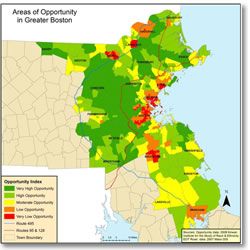1970s–Present: Disparate Impact of
Local Land Use Regulations
In response to the growth of the suburbs, local governments enact zoning policies such as large minimum lot requirements, minimum multifamily zoning, and age restricted zoning which restrict lower income families and families of color from moving to the suburbs.
Introduction
While redlining institutionalized racial segregation in the cities, it was the development of the suburbs via the construction of Route 128 that magnified the effects of segregation by increasing the physical separation between whites and people of color. Municipalities responded to the subsequent in-migration of jobs and people to the suburbs by enacting rigid zoning ordinances. Zoning regulations were created to control density, protect open space, and artificially inflate housing prices. Strict zoning restrictions are still in use today and have a disparate impact on African Americans and Latinos and in particular family households, because they limit affordability and the number of rental multifamily housing opportunities.
Specific land use policies that impact segregation
- The impact of zoning
- Restriction of multi-family zoning
- Impact of special permitting on multi-family housing developments
- Age restricted housing
- Minimum lot size requirements
- Local preferences


